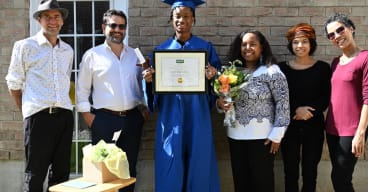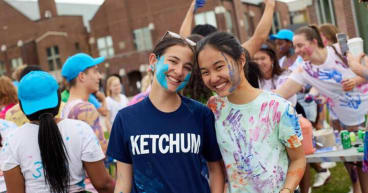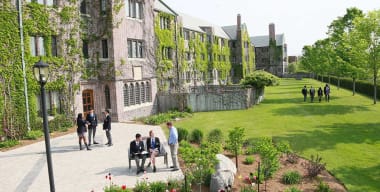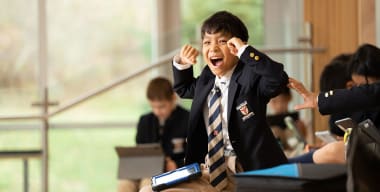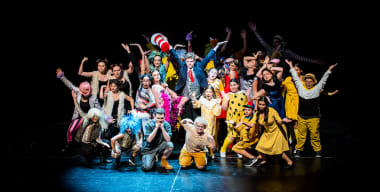When considering the different curricula outlined below, keep in mind that few schools fall neatly into one category. Most schools’ curricula comprise a blend of best practices drawn from multiple curriculum types.
Having said that, most schools do have an overall curriculum type. Each school identifies this within their full profile on OurKids.net. Often, schools also note any curricular adaptations they make at different grade levels.
Mainstream curricula
Traditional
Traditional curricula are content-based and rooted in the core disciplines. This is a structured approach where the teacher delivers a unified curriculum through direct instruction. Students usually learn by observing and listening to their teacher, studying facts and concepts in textbooks, and completing both tests and written assignments. There is a strong focus on the objective evaluation of student work.
This aims to challenge students to not only show their mastery of content, but their ability to analyze and critically assess it. Class discussions are also used to create dialogue around curriculum content.
The approach is based on the philosophy of educational essentialism, according to which students should be imparted with the fundamentals of core subjects in a systematic and disciplined way. Traditional curricula emphasize “core knowledge”— knowledge of facts—prior to higher-order learning activities. The curriculum is delivered in a linear and sequential way: as if laying brick on top of brick. Students only move on to the next step once the previous one has been fully mastered.
Private schools with traditional curricula are popular with those who believe that public schools have abandoned some of their important education features, says Barbara Bierman, executive director of the Ontario Federation of Independent Schools.
Critics of the approach say it applies a one-size-fits-all approach to all students, ignoring their uniqueness. They argue that the top-down instructional style stifles students’ natural sense of exploration and creativity, and that too narrow a focus is placed on academic achievement. This comes at the cost of other developmental goals.
Defenders of traditional curricula say the critics misunderstand their intent: “you can’t connect the dots without first having the dots” is a common refrain.
Progressive
Progressive (sometimes called “inquiry-based”) curricula attempt to place children’s interests and ideas at the heart of the learning experience. Instead of lessons being driven by predetermined pathways, progressive curricula are often “emergent.” Learning activities, on this approach, are shaped by students’ questions about the world.
Instead of starting with academic concepts and then tying it to everyday experience, progressive methods begin with everyday experience and work back to an academic lesson. Teachers provide materials, experiences, tools, and resources to help students investigate a topic or issue. Students are encouraged to explore, reflect on their findings, and discuss answers or solutions.
The curriculum is often structured in a spiral-like fashion, revisiting the same theme or material frequently, with increasing difficulty. Material is also often integrated: it will call on different subject disciplines at the same time.
The approach is more concerned with developing process over content: critical thinking and skills over the transmission of factual knowledge. A common mantra for progressive educators is: “Today’s knowledge will be obsolete soon enough. So it’s more important to teach problem-solving skills than content.” The approach also emphasizes group work and projects over individual tests, assignments, and essays.
Critics of the approach say it de-emphasizes academic work and is inefficient. By rejecting the primacy of core knowledge, critics argue, the progressive approach undermines the basis for future learning. This is because knowledge-acquisition is nlinear: the more you know, the easier it is to learn more.
Defenders of progressive curricula say it is the practice of intellectual engagement that leads to more engagement, not the mechanical acquisition of knowledge.
Liberal arts
Liberal arts curricula share with traditional programs their focus on core knowledge-acquisition, but tend to borrow more best practices from the progressive approach. A liberal arts program might still feature group work and projects, for example, contrary to the more primary focus on tests and essays at a traditional program.
Where the progressive approach tends to prioritize instrumental knowledge—knowledge that can be “used”—the liberal arts approach places more emphasis on theoretical and academic learning. At the heart of the liberal arts approach is the premise that humans are rational beings and that cultivating the intellect is not only an important goal, but is the goal.
Liberal arts curricula encourage deep engagement with some of our "biggest" ideas (e.g., artistic, scientific, philosophical, and mathematical). Attaining this cultural literacy—no matter the teaching method—is a key aim of the approach.
Alternative curricula
International Baccalaureate
The International Baccalaureate (IB) diploma program is a two-year advanced secondary school curriculum that was founded in 1968. It is now taught in schools in more than 140 countries, including many private and alternative schools in Canada.
The core IB curriculum was created for students aged 16 to 19. The IB Primary Years Program, for students aged 3 to 12, and the Middle Years Program, for students aged 11 to 16, prepare students for the diploma program.
In all, the IB program is meant to provide a well-rounded, high quality, and advanced course of study. It's meant to deliver the basics of high school education, while challenging students to apply their knowledge and skills through collaboration, discussion, and communication.
To earn an IB diploma, students must do three things. (1) Complete courses in six core subject areas (language and literature, language acquisition, individuals and societies, sciences, mathematics, and the arts). (2) Write an essay of up to 4,000 words. (3) Take standard, externally assessed exams. In addition to course work, students also need to complete two formal projects and a minimum of 50 hours of community service.
The IB curriculum exceeds the requirements outlined by provincial curricula. The program is seen as rigorous by universities and employers, and students often take great pride in earning an IB diploma. The IB curriculum is often offered at international schools, both in Canada and overseas, because of its near-universal recognition by university admissions offices.
Montessori
Montessori schools offer an alternative to the standard lesson format found in many schools in Canada. Instead of whole-class lessons, Montessori schools often allow students to choose their own tasks or activities. These are often concrete tasks that are self-correcting, and can be completed on one's own or in small groups.
There is emphasis on work that's concrete, hands-on, challenging, and developmentally appropriate. This is meant to promote independence, self-confidence, curiosity, and a love of learning.
Montessori teachers act as guides, setting up the initial conditions (preparing the environment, introducing children to materials) and then challenging students with progressively more difficult material, when appropriate.
A Montessori classroom is typically very calm and orderly, with students either working alone or in small groups, rather than together as an entire class. The decentralized lesson format allows students to work at their own pace.
Classrooms include students of various ages. This includes preschool (1-3 and 3-6), elementary school (6-9 and 9-12), middle school (12-14), and high school programs (14-18). The aim is to provide an environment where younger students learn from older ones, and older students mentor younger ones.
Montessori teachers are often specially certified in Montessori education. There are two main accrediting bodies for Montessori schools in Canada: The Canadian Council of Montessori Administrators (CCMA) and The Association Montessori Internationale (AMI).
Reggio Emilia
Reggio Emilia programs are offered by some schools at the preschool and elementary levels. The approach aims to develop curiosity and problem-solving skills through projects designed to capitalize on children’s interests. To be successful, the approach requires lots of parental involvement—with projects, curriculum, and more—something that's ongoing throughout the school year.
Art is emphasized and incorporated in many projects and activities. Students use lots of different kinds of artistic media thoughout the school year.
Overall, the Reggio Emilia philosophy is highly progressive, promoting child-centred classrooms, discovery learning, and 21st-century literacies.
Waldorf
Waldorf schools are available from preschool to Grade 12, though they are most popular at the younger ages. Rudolf Steiner, the founder of the Waldorf philosophy, believed the educator’s first task is to help students develop an aesthetic appreciation for life and learning. Sometimes incorrectly conflated with Montessori schools, Waldorf schools focus on developing the whole child—emphasizing collaborative, hands-on learning, along with the arts and music, which are integrated into other areas of study.
A Waldorf environment will often feel more like a home than a traditional classroom, designed to instill comfort, familiarity, and a sense of predictability in the students’ day.
To learn more about alternative curricula, read our comparison guides. In separate articles, we compare Montessori to Waldorf, Montessori to Reggio Emilia, and Waldorf to Reggio Emilia school approaches.
Specialty schools
Specialty schools are schools with a specific focus, from arts to sports to sciences
to the environment. Each school offers a full range of academics along with intensive instruction in the specialty.
The school day is mostly organized around the specialty subject. For instance, at a winter sports school, the school day will be arranged to allow students optimal time for practice, and the school year will be organized in order to make time for competitions.
If a student is motivated to excel and wants extra challenges and opportunities, they may be a good fit for a specialty school. These schools have schedules that support development, as well as trained coaches, mentors, and teachers who can nurture students’ talents.
Preschool/daycare curricula
Play-based
Play-based preschools and daycares are founded on the belief that young children learn best through play. Largely open-ended and minimally structured, play-based programs aim to develop social skills and a love of attending school.
Pre-academic skills are taught, but in a less direct way than at an academic program: children play in different stations set up around the classroom, and they choose activities on their own. Stations often contain an indirect lesson or developmental goal. The idea is this better harnesses children’s natural curiosity and intelligence. Play-based classrooms are highly social and active.
Academic
Academic preschools and nursery schools are the most structured of the different preschool curriculum types, and have a strong emphasis on math and reading readiness skills. These programs aim to expose children to what early elementary school is like.
While time is still allotted to free play, much of the day is built around formal lessons guided by the teacher. Classrooms often resemble play-based ones (with different stations set up around the room), but at an academic program, the teacher leads students through the stations directly and ties these activities to a whole-class lesson or theme.
Montessori
Montessori preschools give young learners lots of freedom to choose which tasks or activities interest them. Children often work with Montessori manipulatives—self-correcting puzzles. Lots of focus is placed on concrete and hands-on learning.
Well-trained teachers act as guides, connecting children with meaningful and challenging work. A Montessori classroom is normally calm and orderly, with children working alone or, sometimes, in small groups. The focus is on promoting independence, confidence, and practical and academic skills.
Waldorf
Waldorf preschools are sensitive to the developmental needs of children. They delay academics until kids are ready and interested—normally until grade 1. Waldorf teachers educate the whole child: head, heart, and hands. They develop children’s aptitudes for thinking, feeling, and acting. At the preschool level and up, there is a major focus on art, music, and imagination. This nurtures creativity, curiosity, and a love of learning. Kids also engage in lots of practical activities, such as knitting, woodworking, weaving, and toy making.
Reggio Emilia
Reggio Emilia preschools are child-centred. Teachers and children co-construct the curriculum based on children’s interests. Kids participate in activities and work on projects based on their interests. Reggio preschools focus a lot on the arts and artistic media, such as drawing, painting, modelling, sculpting, music, and dance.
Reggio teachers participate in activities and projects with kids, rather than sitting back and observing. Lots of parent involvement is also encouraged, in class, during field trips, and in constructing the curriculum.
To learn more about the different preschool programs, read our comparison guides. In separate articles, we compare different preschool approaches: academic to play-based, Montessori to Waldorf, Montessori to Reggio Emilia, Waldorf to Reggio Emilia, Montessori to play-based, and Montessori to academic preschool approaches. You can also read our guides to choosing preschool, preschool benefits, and preschool costs.

